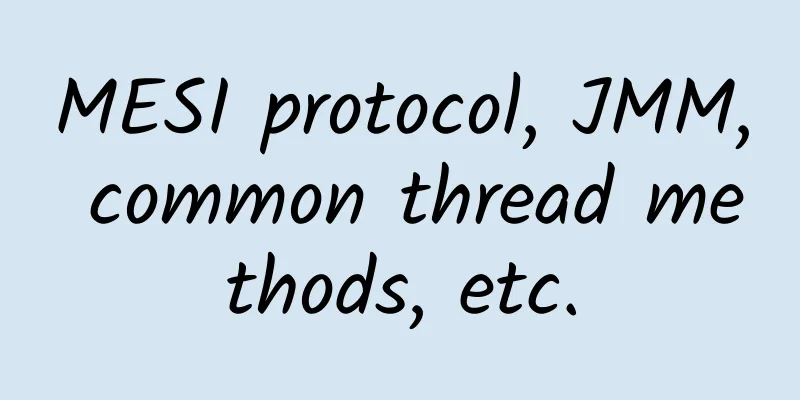MESI protocol, JMM, common thread methods, etc.

|
This article is reproduced from the WeChat public account "Little Sister Learning Java". Please contact the public account of Little Sister Learning Java for reprinting this article. Preface When we are looking for a job, we often see such a line in the recruitment information: multi-threaded concurrent experience is required. Whether you are a junior programmer, an intermediate programmer, or a senior programmer, whether it is a large or small company, concurrent programming is definitely indispensable. However, many blog posts on the Internet directly talk about JUC without starting from the basics, so this article aims to explain the basics of concurrency, mainly the knowledge of computer principles, common thread methods, and Java virtual machine methods, to escort the subsequent learning. Without further ado, let's get started. Cache consistency - MESI protocol CPU multi-level cache official concept Under the guidance of Moore's Law, CPUs are developing at a rate of doubling every 18 months. However, the development speed of memory and hard disk is far slower than that of CPU, so the concept of cache is introduced. We can see from the figure below that a cache is added between the CPU and main memory to improve the interaction speed. As the CPU speed becomes faster and faster, people have higher and higher requirements for computer performance. Traditional cache can no longer meet the requirements, so multi-level cache is introduced, including level 1 cache, level 2 cache, and level 3 cache, as shown in the figure. Level 1 cache: It is basically built into the CPU and runs at the same speed as the CPU, which can effectively improve the CPU's work efficiency. Of course, the more there are, the higher the CPU's work efficiency will be, but because the internal structure of the CPU limits its size, the data of the level 1 cache is not large. L2 cache: Its main function is to coordinate the working efficiency between L1 cache and memory. The CPU first uses L1 memory. When the CPU speed increases gradually, the L1 cache is not enough for the CPU usage, so L2 memory is needed. Level 3 cache: It has a similar relationship to level 1 cache and level 2 cache. It is a cache method designed for when the reading of level 2 cache is not enough. In a CPU with level 3 cache, only about 5% of the data needs to be retrieved from the memory, which can improve the efficiency of the CPU a lot, so that the CPU can work at high speed. We can take a look at the cache status of this machine. CPU multi-level cache vernacular translation Only the first level cache: We can regard the CPU as ourselves, the cache area as a supermarket, and the main memory as a factory. If we want to buy something (get data), we go to the supermarket (cache area) to buy (get it) first. If the supermarket (cache area) does not have it, we go to the factory (main memory) to buy (get it). Multi-level cache situation: We can think of the CPU as ourselves, the L1 cache as the store in the neighborhood downstairs, the L2 cache as an ordinary supermarket, the L3 cache as a large supermarket, and the main memory as a factory. If we want to buy something, we go to the store downstairs (L1 cache) first. If the store (L1 cache) doesn't have it, we go to the ordinary supermarket (L2 cache). If the ordinary supermarket (L2 cache) doesn't have it, we go to the large supermarket (L3 cache). If the large supermarket (L3 cache) doesn't have it, we go directly to the factory (main memory) to get it. The emergence of these caches means that we don't have to go to the factory (main memory) every time to buy things (get data), which saves time and improves speed. Why do we need CPU cache? The CPU speed is too fast, so fast that the memory cannot keep up. During the processor processing cycle, the CPU often waits for the memory, resulting in a waste of resources. The significance of cache Time limitation: If a piece of data is accessed, it may also be accessed at some time in the future. (If I buy potato chips today, I may buy potato chips again in the future, after all, I am a foodie O(∩_∩)O) Spatial limitations: If a piece of data is accessed, then its adjacent data may also be accessed. (In plain language, if I buy potato chips today, I may also buy other puffed foods, after all, they are next to each other) The problems For multi-core systems, there is a problem of inconsistent cache data in each core. Solution 1: Bus Lock (Performance is Too Low) The CPU reads data from the main memory to the cache area and locks the data on the bus. Other CPUs cannot read or write the data until the CPU has used the data and the lock is released. For example, I want to buy a spicy bar at the supermarket, but Zhang San also wants to buy one. During the process of buying, the spicy bar is locked, and Zhang San can't touch it at all. My buying process is very slow, so Zhang San is very anxious. Solution 2: MESI protocol (key point) In response to the above situation of inconsistent cache data, the MESI protocol is proposed to ensure the consistency of shared data in multiple CPU caches, and four cache line states are defined, namely M (Modified), E (Exclusive), S (Share), and I (Invalid).
Migration between MESI states: This picture may seem confusing at first glance. Let’s take a closer look at it and slowly experience these changes. The current status is Modified
Current status is Exclusive
Current status is Share
The current status is Invalid
The difference between parallelism and concurrency Concurrency: Only one instruction can be executed at the same time, but multiple instructions are executed by the CPU in rotation. Because the time interval is very short, it will create the illusion of simultaneous execution. Parallelism: Multiple instructions are executed simultaneously on multiple processors at the same time, whether at the micro or macro level. For example, concurrency is when a housewife has to cook, take care of the baby, and clean the room. If she only does each task for one minute and then rotates, from a macro perspective, it will create the illusion of simultaneous execution. Parallelism is when the housewife hires two nannies, one for cooking and one for taking care of the baby, and she is responsible for cleaning. Whether from a macro or micro perspective, they are all executing at the same time. A certain boss once said the difference between the two: concurrency is the ability to deal with multiple things at the same time, and parallelism is the ability to do multiple things at the same time. As an engineering student, I don't know how to praise the boss, I just know how to shout 666. The relationship between processes and threads Processes are used to load instructions, manage memory, and execute statements. A thread is a part of a process, and a process can be divided into one or more threads. Opening NetEase Cloud Music starts a process, while playing, searching, commenting, etc. are all threads. Communication between threads Communication between threads is relatively simple and can be done through their shared memory. For details, see the Java Memory Model section below. Communication between processes The communication between processes is more complicated. For the same computer, the communication is called IPC; for different computers, the communication requires a network and follows mutually agreed protocols, such as HTTP, etc. This part is hardware-oriented, so I dare not say or ask. The state of the thread (from the hardware level) Initial state: A new thread is created, no steps have been taken, and it has not yet been associated with the hardware. Runnable state: When the start method is called, the program enters the runnable state (ready state), but the time slice has not been obtained at this time. The specific time of running depends on the hardware. Running state: When the CPU allocates a time slice to a thread, the thread enters the running state. Blocking state: When a thread calls a blocking API, the thread does not use the CPU and enters a blocking state. Termination state: When a thread finishes running, it enters the termination state. Some common thread operations Three ways to create threads Thread and task merging
Separation of threads and tasks
FutureTask returns the execution result
Thread start
Here, start means entering the ready state, that is, the running state. The specific time depends on the CPU. Wait for the thread to finish joining Without join:
Running results: When to use join:
Running results: In the first case without the join method, the main thread start and main thread end are both in front and close together, while the thread start and thread end are in the back, because they are two different threads and do not interfere with each other. In the second case with the join method, the main thread ends at the last line, because the join method needs to wait for the child thread to end before continuing to execute the following code. Get thread id, name, priority
Running results: Java Memory Model - JMM Memory Model It is similar to multi-level cache. Each thread has working memory, which stores a copy of the data in the main memory, as shown in the figure below. If there is a variable a=1 in the main memory, and threads A, B, and C all store a copy of a=1, thread A adds 1 to it and refreshes it to the main memory. However, threads B and C do not know this, so there is a problem. How to solve this problem? I will explain it slowly below, don't rush. 8 atomic operations (concepts) The following are 8 atomic operations. Please take a look at them. They will be described in detail below.
8 atomic operations (examples) Let's draw a picture based on the above example. Please forgive me for being stupid and the picture is a bit ugly. 1. read: read a=1 from the main memory. 2.load: load a=1 from the main memory into the working memory of thread A. 3. Use: read a=1 from the working memory of thread A and perform a self-increment operation. 4.assign: write a=2 to the working memory of thread A. 5.store storage: store a=2 in main memory. 6.write: write a=2 to the a variable in the main memory. 7. Lock: In the above method 1 to solve CPU cache inconsistency, when thread A operates, the main memory a variable is locked (locked), and thread B cannot read the a variable at all. 8. Unlock: After thread A unlocks, it unlocks the main memory a variable, and thread B can read the a variable and operate on it. Note: There is a performance problem with lock and unlock. We found that the code we wrote is clearly a multi-threaded concurrent operation, but the underlying layer is still serialized and does not truly achieve concurrency. Visibility Principle The MESI protocol mentioned above is implemented on the bus. Threads A and B can simultaneously obtain the value of a in the main memory. After a is incremented, it will pass through the bus when performing the write operation 6write. Thread B has been using sniffing to monitor the variable a that it is interested in on the bus. Once it finds that the value of a has been modified, it immediately sets a in its working memory to invalid (using the MESI protocol) and immediately reads the value of a from the main memory. At this time, a in the bus has not been written to the memory, so there is a short lock process. After a is written to the memory, the unlock operation is performed, and thread B can read the new value of a. Although this process also has lock and unlock operations, the granularity of the lock is reduced. Risks and advantages of concurrency Advantages:
risk:
Conclusion This is the foundation of the concurrency series, mainly talking about the hardware MESI protocol, the eight atomic operations, the relationship between threads and processes, some basic operations of threads, the foundation of JMM, etc. |
>>: To prevent 5G from the barrel effect, both Sub-6GHz and millimeter wave are indispensable
Recommend
10 hottest enterprise networking startups in 2019
Cloud computing, automation, and intent-based net...
Is 6G going to overturn 5G? Musk: No, it’s my satellite internet
It stands to reason that with 5G already official...
RAKsmart server flash sale $30/month, cloud server 30% off, cluster server/high bandwidth server continue to sell well
RAKsmart has also launched the most important 11....
5G messaging: The key is how to divide the money
[[439892]] The 5G news that had just been quiet i...
A detailed introduction to the difference between WiFi5 and WiFi6 network speeds
I believe that most of my friends will fully cons...
I’ve explained the QUIC protocol in ten minutes. Do you understand it?
Let's review the development of HTTP. First, ...
5G private network is a big watermelon (Part 2): The mystery of the collision
In the first article of this series, we explained...
Satellite Internet: The war is already raging
[[323965]] On April 20, satellite Internet was cl...
Pour some cold water on the "feverish" 5G concept: the market is far from mature
The popularity of 5G networks, 5G mobile phones, ...
How far can a SaaS company go? Mainly determined by these two indicators
[[356547]] To see the current status of a SaaS co...
Is working from home a good idea? See which companies are hiring remote developers
【51CTO.com Quick Translation】 When you encounter ...
With unlimited data and 5G coming, how far are we from eliminating Wi-Fi?
According to media reports, Wi-Fi may be phased o...
Teach you how to solve the WiFi coverage problem in various apartment types
Weekend nights are all about having fun! Playing ...
The benefits of 5G technology for education upgrades
With over 250 million students, India has one of ...
Do you know all the things you need to pay attention to when using threads?
[[344283]] This article is reprinted from the WeC...









